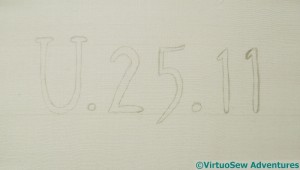Typed on camelback in a sandstorm
One of the reasons Mary Chubb was sent out to Egypt with the Expedition was to ease the administrative burden in London by bringing the administration of the dig under control. In the nineteen twenties, of course, typing was not the mundane skill it has become, and although there was a typewriter in the Dig House, the excavation directors were not skilled in its operation, producing typed reports that looked, in Mary’s words, “as though they had been typed on camelback in a sandstorm”. The first task when a report arrived had always been to retype it into a more legible format so that no-one other than the secretaries would have to struggle to decipher it.
When she is out in Egypt, she soon discovers that some of the difficulties are not easily surmountable, even by an experienced typist. Sand adheres to the damp ink left by the typewriter ribbon, creating “a rather pretty embossed effect”, which sadly she isn’t always in the mood to appreciate, especially when dragged away from difficult, painstaking typing of lists to help with the excavation of delicate finds..
It was easy enough to work out how to represent the sand sticking to the paper – close-packed French knots in a mixture of sandy colours – but not so easy to decide what text to use. Maybe “faience”, a commonly used material for jewellery and ornaments? The names of the expedition members? References ascribed to finds?
In the end I settled on “U.25.11”, which was the site grid reference for the Expedition House, which was built up on the remains of an original house of the Amarna period. I don’t, of course, know precisely which typewriter Mary used, so I have sketched onto the fabric something that looks a little bit like typescript. It isn’t exactly right, but the letter and digit forms have been sketched from looking at the letters in a typescript we recently found, of an article my father wrote in the 1960s. My whole family is going to be involved in this project, whether they like it or not, and by whatever circuitous route I may devise…


I like it!
Consider too – does the sand adhere consistently to all the letters, or should you leave gaps in your French knots? Your call, but just an idea…
What a fascinating life she led!
I like it too! I am really enjoying watching this project develop.
Perfect!
I too like the alphabet and numbers combination… When I read ‘ sand adheres to the damp ink left by the type writer’ I thought French knots on painted text.. Looking forward to see what your idea is..
I love this story and the alphabet and numbers combination. Oh how I remember my early typing years on manual typewriters where the embossed metal letter would snap up to the ribbon and hit the paper. The ribbons in those days were fabric and oh soooo messy. I did love, however, the ‘clack’ of the letter hitting the paper — not the silent typing that we all do now.
The plot thickens, both back at the time of the expedition and now. I think that grid reference is inspired.
Such a lot of thought! I agree with what everyone else has written. What a good idea to use the grid reference. I agree also about the sand not sticking uniformly!
What a lovely picture your title conjured up, of someone perched on a camel, typing away! Have fun working all those French knots!!
Camels, old typewriters, french knots, all in one post? What’s not to love?